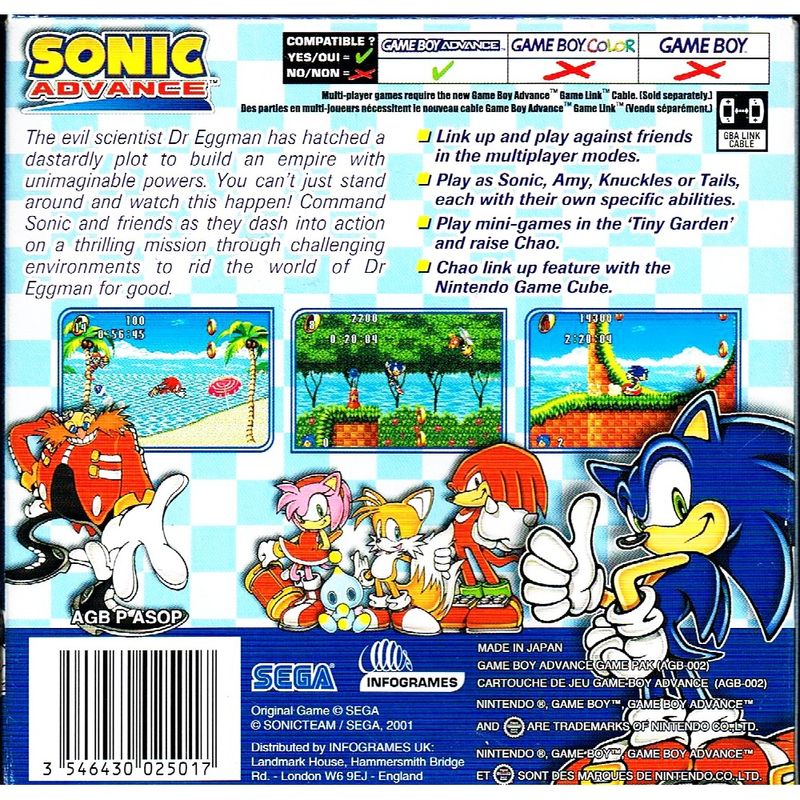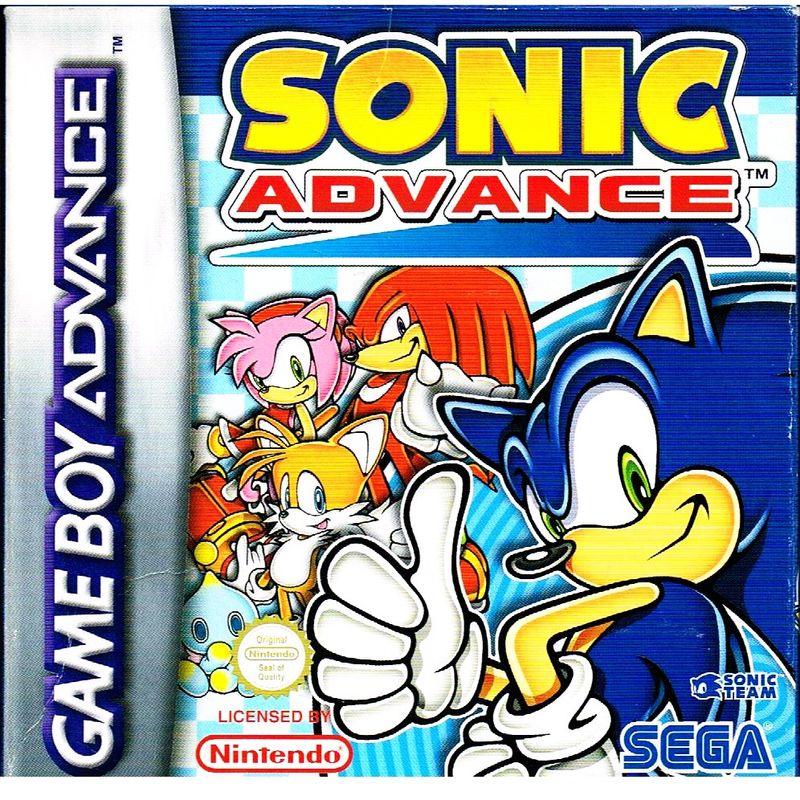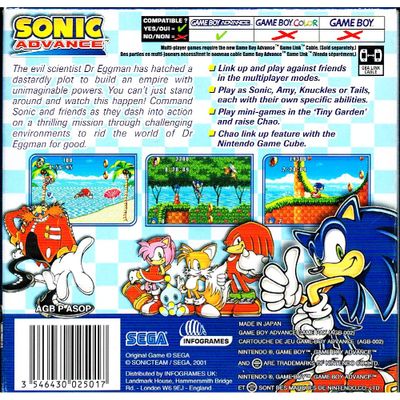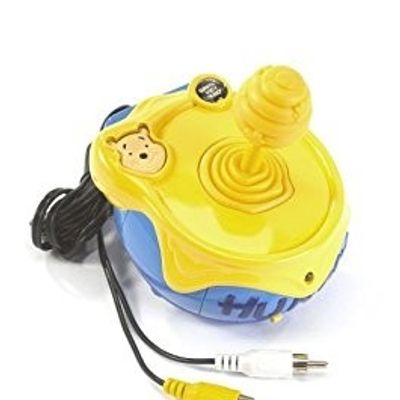SONIC ADVANCE GAMEBOY ADVANCE
Liknande produkter
Beskrivning av SONIC ADVANCE GAMEBOY ADVANCE
SONIC ADVANCE GAMEBOY ADVANCE - AGP-AS0P-UKV
Sonic Advance (Sonikku Adobansu) is a 2001 platform game in the Sonic the Hedgehog series, developed by Dimps and Sonic Team and published in Japan by Sega for the Game Boy Advance. It was later published by THQ in North America and by Infogrames in PAL regions. It was released in Japan on December 20, 2001, in North America on February 3, 2002 and in PAL regions on March 8, 2002. There were also releases on three Twin Pack cartridges bundled with Sonic Pinball Party, Sonic Battle and ChuChu Rocket! respectively in 2005. It was one of the first Sonic games to be released on a Nintendo platform.
Sonic Advance was ported to the Nokia N-Gage on October 7, 2003 under the title SonicN. A version for Android devices was released in Japan on November 25, 2011. The game was later released on the Wii U's Virtual Console in Japan in February 2015.
The game follows Sonic and his friends as they travel through various zones in order to stop Dr. Eggman from taking over South Island. The game features four playable characters; Sonic, Tails, Knuckles and Amy. Each character has the same moveset as they did in Sonic the Hedgehog 3 and Sonic & Knuckles, with the addition of a melee attack. Each character has a special ability, such as Sonic's splice shield, Tails' flight and Knuckles' gliding and climbing abilities. In her playable 2D debut, Amy cannot perform the Spin Dash or get into ball form when jumping like the others, and must rely on her Piko Piko Hammer to defend herself, making her unique amongst the characters. Grind rails first introduced in Sonic Adventure 2 also make their first 2D appearance. Sonic and Tails can also be used at the same time during the story by inputting a cheat code at the character selection screen. When playing as both characters, the gameplay is similar to that of Sonic the Hedgehog 2: The player can only control Sonic and a CPU-controlled Tails follows him.
There are 6 normal zones, each of which contains two acts. In each zone, Act 1 is cleared by reaching the goal and Act 2 is cleared by destroying the boss robot at the end and opening a capsule which subsequently falls and releasing animals trapped inside it.
If the character is damaged, they will drop all their rings, however, if the character has no rings and takes damage, they will lose a life. A character will also lose a life if they spend too long underwater without replenishing air supply (air underwater lasts for 18 seconds), fall into a gap, or if the time exceeds 9 minutes and 59 seconds. In the first act of the sixth zone, the player will have 5 minutes to get to the next section. If player fails to get to the next section before the timer counts down to 0, they will lose a life. Losing a life will require a character to start from the last checkpoint passed, or from the beginning of the act if they have not passed any checkpoints. If a character loses a live when the number of lives remaining is zero, the game will end.
Special Springs can be found near the top of certain acts. Each normal zone contains one Special Spring, except for Ice Mountain Zone which contains two: one in each act. By jumping onto these springs, the player can reach a Special Stage—each spring goes to a certain special stage every time it is jumped on. The stages see players fall down a tube on snowboards while trying to earn enough rings to complete the target amount. By winning the stage, the player receives a Chaos Emerald, although there is only one emerald per stage, so the same stage cannot be repeated for multiple emeralds. Unlike most other classic 2D Sonic games, the Emeralds are "shared" between all the characters. Once the player has collected all the Emeralds and completed the X-Zone with all four characters, they can access the Moon Zone by completing the X-Zone again with Sonic.
Sonic Advance, like Sonic Advance 2 and Sonic Pinball Party, features an extra game called the Tiny Chao Garden, in which players can raise Chao. Players can transfer their Chao between the Tiny Chao Garden and the Chao Garden from the GameCube versions of Sonic Adventure and Sonic Adventure 2. Tiny Chao Garden is more limited than the Chao Garden: Chao don't age, can only interact with fruit and three toys (which must be bought in the Tiny Chao Garden itself), and only one Chao can be in it at once. An egg can be stored in the garden too, and hatches as soon as there is no Chao in it. Chao can only leave the garden by being transferred to the Chao Garden or by running away when players don't take care of them. Fruit, toys and eggs must be bought with the rings collected in the normal game or two minigames. Rings, fruit and eggs can be transferred to the Chao Garden, but not from it.
Box: AGB P ASOP
Manual: AGB-ASOP-UKV
Kassett: AGB-ASOP-UKV
Innerkartong: Papp
KOMPLETT I BOX






